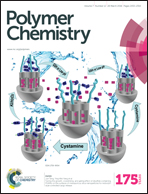Tuning the growth, crosslinking, and gating effect of disulfide-containing PGMAs on the surfaces of mesoporous silica nanoparticles for redox/pH dual-controlled cargo release†
Abstract
The surface modification of mesoporous silica nanoparticles (MSNs) with poly(glycidyl methacrylate) (PGMA) was conducted through surface-initiated atom transfer radical polymerization (SI-ATRP). The pendant epoxide of PGMA was ring-opened by cystamine dihydrochloride, a disulfide bond-based bifunctional primary amine. The grafted PGMAs on MSN surfaces could then be cross-linked by changing the stoichiometric ratio of the epoxide to cystamine or through a KI/H2O2 (30%) assisted disulfide bond exchange after ring opening by cystamine dihydrochloride. The MSN–PGMA hybrid nanocarriers show excellent cargo release behaviour in response to the changes of external pH. Significantly, these disulfide linkages on MSNs can be cleaved in the presence of physiological concentrations of glutathione (GSH) in cancer cells, so that the surface PGMA network degrades thus opening the pore entrances for cargo release. These disulfide cross-linked PGMA network-coated MSNs are of great interest for on-demand anticancer drug delivery applications.



 Please wait while we load your content...
Please wait while we load your content...